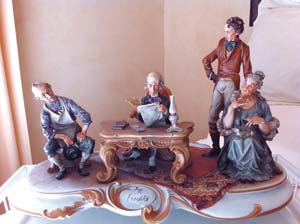 Diana sent me a figurine named “Ereolita,” early 20th century Capodimonte porcelain in the classical style by Giuseppe Gricci. In the mid-1700s King Charles VII of Naples, an independent kingdom in those days, established The Royal Factory. These bear the fleur-de-lis mark of the king, who moved the factory to Spain when Charles took over the throne there, leaving Italy to his son, Ferdinand. Ferdinand reopened the factory in Italy, marking pieces with a crown and the Neapolitan “N” mark. In the early 20th century many porcelain artists originally part of the Neapolitan factory broke away. They marked their pieces with a crown and “N,” in the Capodimonte tradition.
Diana sent me a figurine named “Ereolita,” early 20th century Capodimonte porcelain in the classical style by Giuseppe Gricci. In the mid-1700s King Charles VII of Naples, an independent kingdom in those days, established The Royal Factory. These bear the fleur-de-lis mark of the king, who moved the factory to Spain when Charles took over the throne there, leaving Italy to his son, Ferdinand. Ferdinand reopened the factory in Italy, marking pieces with a crown and the Neapolitan “N” mark. In the early 20th century many porcelain artists originally part of the Neapolitan factory broke away. They marked their pieces with a crown and “N,” in the Capodimonte tradition.
Capodimonte porcelain
We ascertain value in Capodimonte by attention to detail because many factories worked in this style. The best ones painted in fine detail, especially the painted features of a face. Liberace became one of the foremost collectors of Capodimonte in the 20th century. His now-shuttered Liberace Museum in Las Vegas (where else?) held a collection of figurines similar to Diana’s.
Diana’s piece depicts the story of a wealthy and miserly old landlady, “Ereolita,” who sits with her son above her, as her lawyer reads her workman tenant, his hat in hand, the riot act for his delinquency. Diana’s piece is worth $7,500 in perfect condition, which Diana tells me it definitely is, having belonged to her 93-year-old grandmother.
Masquerading as Porcelain
Tony sent me a photograph of a “Chinese vase.” One look told me it’s not porcelain but a metal vessel. The design made by painstakingly inserting colored glass paste within hand-hammered copper or bronze wires soldered onto the metal body. The artist paints the glass paste, or enamel, into these small partitions (in French, “cloisons”). He then fires the vessel. Because enamel shrinks under heat, he repaints the vessel and refires it several times. Once finished he hand-rubbed the vessel down to the edges of the cloisons so they become faintly visible. The result appears flamboyant and gorgeous.
The Mongol (Islamic) people introduced this very early and complex art form to China in the late 13th century. One of the first books on antiques mentions that wares of this type are only suitable in ladies’ chambers due to their gorgeous colors. Cao Zhao writes in 1388 in Gegu Yaolun (Guide to the Study of Antiques) that cloisonne is not suitable for a sober scholar’s home, only for ladies or kings.
Tony’s vase, in the baluster form, dates from 1890 to 1920, with symbols of dragons and flowers in a dark red area, called a “cartouche,” a shield-form medallion. I know Tony’s vase comes from the late 19th century Meiji period because of the “Western” or Occidental taste for symmetry, expressly designed for the European market. This vase is worth $650 missing its mate. They produced these vases in pairs for late 19th century mantelpieces because the European taste sought binaries (even numbers) while the Asian taste leaned to asymmetry (odd numbers).